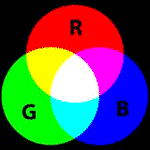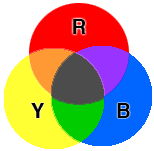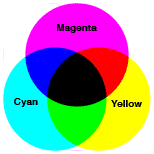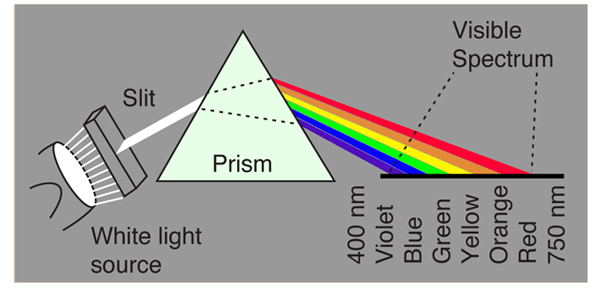
| COLORS AND LIGHT Colors :
Are Black & White Colors? Is Black a Color? Is White a Color?
The answer to the question - "Are black and white colors?" - is one of the most debated issues about color. Ask a scientist and you'll get a reply based on physics: “Black is not a color, white is a color.” Ask an artist or a child with crayons and you'll get another: “Black is a color, white is not a color.” (Maybe!)
There are four sections on this page that present the best answers :
How Colors Exist :
1 - The First Answer : Color Theory 1 - Color as Light
2 - The Second Answer : Color Theory 2 - Color as Pigment or Molecular
Coloring Agents
3 - The Third and Most Complete Answer : Vision and Reflection
Comments from color pros: More about black & white
A basic understanding of how colors are created is the first step in providing correct answers :
The color of a tangible object is the result of pigments or molecular coloring agents. For example, the color of a red apple (in the illustration at the left) is the result of molecular coloring agents on the surface of the apple. Also, a painting of a red apple is the result of red pigments used to create the image.
The colors of objects viewed on a television set or on a computer monitor are the result of colored light (in the illustration at the right). If you're not familiar with how colors are created by light, look at your monitor or television screen close up. Put your eye right up against the screen. A small magnifying glass might help. This is what you will see :
A simplified way to explain it is that the color of a red apple on a computer or television is created by photons of red light that are transmitted within the electronic system.
Primary Colors :
It's also important to understand the concept of "primary" colors. The fundamental rule is that there are three colors that cannot be made by mixing other colors together. These three, red, blue, and yellow, are known as the primary colors.
Now that we've described two different categories of colors (pigment and light-generated) and have a definition of primary colors, the answer to whether black and white are colors can be answered.Color Theory 1 - Color as Light.
Additive Color Theory :
Red, Green, and Blue (The primary colors of light) The
question :
Black and white cats generated on a television These colors are created by light.
The
answers :
Explanation
:
2. White is the blending of all colors and is a color.
Explanation
:
Fact : The sum of all the colors of light add up to white. This is additive color theory.
When you're finished with black & white, explore some real colors at Color Matters: The Meanings of Color
Color Theory 2 - Color as Pigment or Molecular Coloring Agents
Subtractive Color Theory :
Cyan, Magenta, and Yellow (The primary colors of inks in the printing industry) The
question :
Black and white cats created by colored crayons This is color generated by pigments.
Black and white cats The colors of the fur is the result of molecules.
The answers : 
Explanation
:
Therefore, if someone argues that black is the absence of color, you can reply, “What is in a tube of black paint?” However, you must add the fact that black is a color when you are referring to the color of pigments and the coloring agents of tangible objects.
The grey area :
Technically, pure white is the absence of color. In other words, you can't mix colors to create white. Therefore, white is the absence of color in the strictest sense of the definition.
However, when you examine the pigment chemistry of white, ground-up substances (such as chalk and bone) or chemicals (such as titanium and zinc) are used to create the many nuances of white in paint, chalk, crayons - and even products such as Noxema. It's worth noting that white paper is made by bleaching tree bark (paper pulp). Therefore, you could say that white is a color in the context of pigment chemistry.
Light :
Light is a type of energy. It is a form of electromagnetic radiation of a wavelength which can be detected by the human eye.It is a small part of the electromagnetic spectrum and radiation given off by stars like the sun. Animals can also see light. Light exists in tiny packets called photons. It shows properties of both waves and particles. The study of light, known as optics, is an important research area in modern physics.
Light is electromagnetic radiation that is in the form of a wave. Each wave has a wavelength or frequency. The human eye sees each frequency as a different color. Rainbows show the entire spectrum of visible light. The separate colors, moving in from the outer edges, are usually listed as red, orange, yellow, green, blue, and violet. Other colors can be seen only with special cameras or instruments: outside of red is infrared, and inside of violet is ultraviolet.
The other main properties of light are intensity, polarization, phase and orbital angular momentum.
Every color of light has a different wavelength. The shorter the wavelength, the more energy the light has. The speed at which light moves does not depend on its energy. Going through partly clear objects can slow light down by a very small amount.
White Light :
When all of the wavelengths between 780 nm and 390 nm enter our eyes in roughly equal intensity, we perceive white light. White light is the sum of all of the colours of a rainbow.
One of the most important experiments on light was made by Isaac Newton. He was the greatest of all English men of science. He discovered that sunshine (white light) is made up of many colors. Over 300 years ago, Sir Isaac Newton passed a beam of white light through a prism. A prism is a triangular piece of glass, which allows light to spread out into a band of six colors. These colors are red, orange, yellow, green, blue and violet. Newton then sent this light through a second prism where the light became white once again. What did Sir Isaac Newton do? He first took the white light apart and then he put it back together again.
The most common example of a spectrum is the rainbow created in nature.
Lights acts as a stream of particles and as waves. It is made of tiny packets of energy calledphotons. Light is made of various waves, but the length of these waves determine the color of light. Violet has about 70,000 waves to the inch and red light has about 40,000 waves to the inch. Where will you find the other colors? All the other colors are in between the light spectrum.
We do not know of anything in our universe that travels faster than light. The sunlight we see today left the sun 93 million miles away to reach us about 10 minutes later. Light from stars farther away may have taken billions of years to reach our eyes. How many times can light travel around the world while you are saying your name? More than four times.
There are colors which are invisible. These are called infrared and ultraviolet. The human eye is unable to see these colors, but science has special photographic films which can see them.
The rainbow is caused by sunshine (white light) shining on water droplets that are in the air just after a summer shower. Thousands of these water droplets break up the light, just like Sir Isaac Newton's prism. Can you make a rainbow? Of course! Make your own rainbow by turning on the garden hose, which has a nozzle that will make a fine mist, or spray. Make sure the sunlight is coming over your shoulder. You have made a rainbow.
Sir Isaac Newton thought that light was made of tiny particles that flowed in a stream from a light source. |







